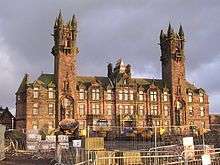Gartloch Hospital

Gartloch Hospital was a mental hospital located on the Gartloch Road near the village of Gartcosh. It opened in 1896 and officially closed in 1996 with patients and staff relocated across Glasgow.[1] Coordinates: 55°52′46″N 4°06′17″W / 55.87958°N 4.10469°W
Buildings
Although many of the surrounding buildings have been converted into homes or demolished, the Category A listed[2] administration building remains derelict. The administration building is a popular destination for urban explorers and many images and videos of the decaying building can be found online from before its closure and after its closure and even during the abandonment period from 1996-2004.
It was closed in 1996 after serving patients for 100 years as a hospital. It is now in the process of being redeveloped into a "luxury village" called Gartloch Village.
As of April 2015, Gartloch Village is nearing completion although another selection of houses due to be built the rest of the village is basically if not completely finished. The main Administrative Building most famous for its two towers is still to be touched and has been derelict since Gartloch's closure in 1996, the only changes being the windows were removed and a fence boundary has been placed around it. The Administration building is due to be complete in the near future.The former Mortuary is due to be turned into a public bar although this may not happen.
Timeline
1889: Gartloch Estate was bought by the City of Glasgow for nearly £8,600 for the Glasgow District Lunacy Board to build an asylum for the poor people of the city.
- 1896: The first patients were admitted. 540 beds.
- 1899: The average number of patients resident in the asylum during the year was 465 and comprised 236 males and 229 females.
- 1902: A tuberculosis sanitorium was opened. It closed after World War II. During the War, Gartloch was transformed into an Emergency Medical Services hospital. Psychiatric patients were transferred to other hospitals and a number of "temporary" hutted wards built.
- 1904: 830 beds.
- 1948: Gartloch joined the National Health Service and was linked with the local Stoneyetts and Woodilee hospitals under the Board of Management for Glasgow North-Eastern Mental Hospitals.
- 1974: When the Greater Glasgow Health Board was created in 1974 Gartloch was placed within the Eastern District.
- 1990: 530 beds.
- 1993: Gartloch was under the Greater Glasgow Community and Mental Health Services NHS Trust, and was being used for a programme called "Takin Over The Asylum"
- 1996: Gartloch Hospital closed.
- 2003: Development work to turn Gartloch into a luxury village begins.
- 2013: Most of the hospital buildings demolished or made into apartments and homes. The once vast gardens have been clogged with water and are being completely ripped out and becoming open land for the villagers
- 2014: Category A listed buildings to be finished for a decorative surrounding area Gartloch village to be officially finished.
Media
In 1993, it was used in the BBC television series Takin' Over the Asylum starting David Tennant and Ken Stott where its distinctive French Renaissance style architecture served as the exterior of the fictional St. Jude's Hospital which aired in 1994. In 2005 a film Gartloch Hospital was released which gave an account of the history of the hospital. It was the winner in the Best Factual Film at the Scottish Mental Health Art and Film Festival, 2007.[3]
Notable people
- Robin Farquharson was an inmate here at the time he joined the Scottish Union of Mental Patients.[4]
References
- ↑ "Records of Gartloch Hospital, Lanarkshire, Scotland - Archives Hub". archiveshub.ac.uk. 2012. Archived from the original on 22 April 2012. Retrieved 15 May 2012.
- ↑ "Historic Scotland Listed Building Report". Hsewsf.sedsh.gov.uk. Retrieved 15 May 2012.
- ↑ "Gartloch Hospital". Vimeo.com. Retrieved 8 September 2018.
- ↑ "Mental Health and Survivors Movements". Studymore.org.uk. Retrieved 8 September 2018.
External links
| Wikimedia Commons has media related to Gartloch Hospital. |
- Gartloch page on Monklands Online has a rare image of hospital with steeples intact